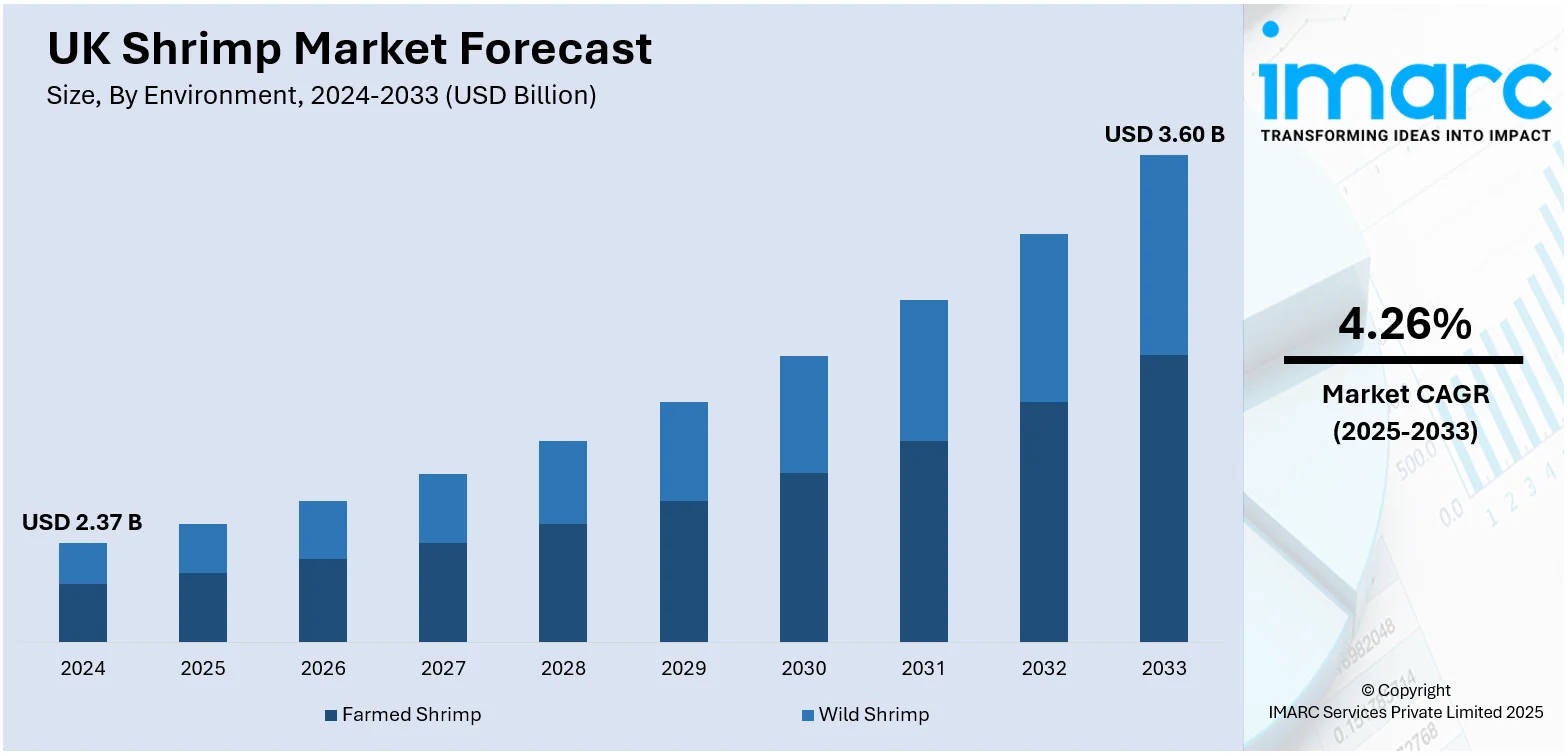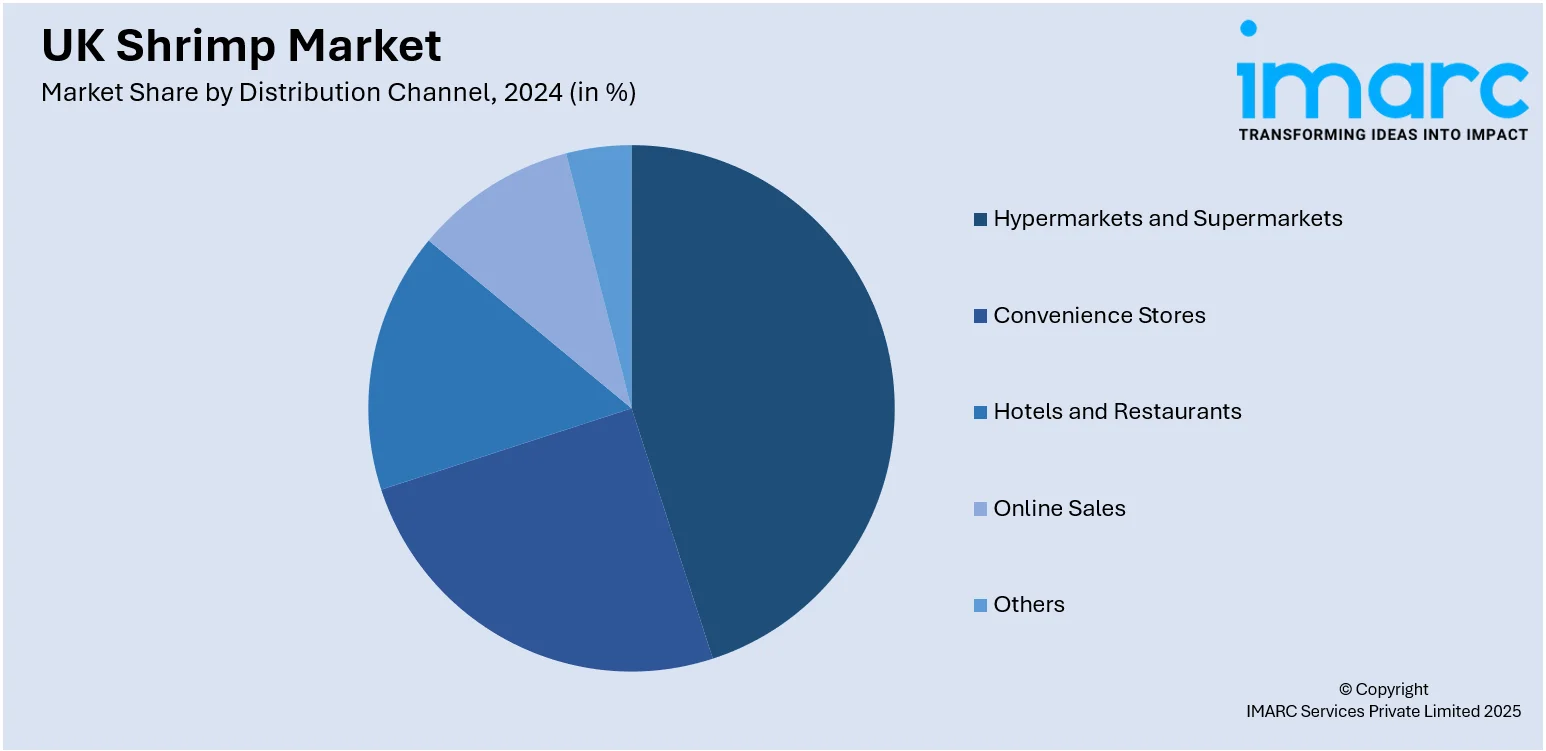
UK Shrimp Market Size, Share, Trends and Forecast by Environment, Species, Shrimp Size, Distribution Channel, and Region, 2025-2033
UK Shrimp Market Overview:
The UK shrimp market size reached USD 2.37 Billion in 2024. The market is projected to reach USD 3.60 Billion by 2033, exhibiting a growth rate (CAGR) of 4.26% during 2025-2033. The market is experiencing growth driven by rising consumer preference for sustainable seafood options and increased shrimp incorporation in dining menus. As consumers demand more ethically sourced products, the UK shrimp market share is expanding, benefiting from advancements in both the retail and food service sectors.
|
Report Attribute
|
Key Statistics
|
|---|---|
|
Base Year
|
2024 |
|
Forecast Years
|
2025-2033
|
|
Historical Years
|
2019-2024
|
| Market Size in 2024 | USD 2.37 Billion |
| Market Forecast in 2033 | USD 3.60 Billion |
| Market Growth Rate 2025-2033 | 4.26% |
UK Shrimp Market Trends:
Surging Demand for Sustainable Shrimp
Sustainability is increasingly a major issue in the UK shrimp industry, affecting business operations and consumer habits. With the growing number of consumers switching to ethically sourced seafood, demand for responsibly farmed and wild-caught shrimp has increased significantly. Due to growing awareness of environmental issues, shrimp suppliers are under pressure to satisfy higher levels of sustainability. In addition, MSC (Marine Stewardship Council) and ASC (Aquaculture Stewardship Council) certifications are becoming increasingly prominent in the marketplace. Suppliers and retailers specializing in environmentally friendly production will benefit in the competitive UK shrimp market. The move towards sustainability is also fueling the development of alternatives to shrimp, such as plant-based or laboratory-grown shrimp products, offering the consumer more environmentally friendly options. As a result, shrimp suppliers in the UK are enhancing traceability in their sourcing processes, ensuring consumers have access to transparent and ethical product information. Additionally, advancements in packaging are reducing waste and encouraging sustainability. These trends impact the UK shrimp market significantly, and companies that adjust to these consumer requirements will do well in the long run. Being sustainable is no longer a trend but is becoming rapidly a decisive element of market success.

To get more information on this market, Request Sample
Rise of Shrimp in UK Restaurants
The growing popularity of shrimp in restaurants and restaurants is another key driver in the UK market growth. Restaurateurs and chefs are adding shrimp to varied menus, from classic to creative gourmet offerings. The trend is most evident in the growth of seafood-fast-casual restaurants and increasing shrimp visibility on upscale restaurant menus. With its versatility and high degree of adaptability, shrimp is emerging as a go-to ingredient for consumers, particularly in Asian and Mediterranean cooking. As part of the increasing popularity of dining out, shrimp is being showcased as a main course and as a component of numerous appetizers, salads, and fusion foods. Along with restaurants, the growing demand for shrimp is impacting food service operators, who are diversifying their product lines to incorporate shrimp-based snacks and ready-to-eat meals. The rising popularity of shrimp in restaurants mirrors customers' increasing desire for quick and nutritious meals. The UK shrimp market will continue to gain from this trend as more individuals adopt shrimp as a part of their meals, both casual and fine dining.
UK Shrimp Market Segmentation:
IMARC Group provides an analysis of the key trends in each segment of the market, along with forecasts at the country and regional level for 2025-2033. Our report has categorized the market based on environment, species, shrimp size, and distribution channel.
Environment Insights:
- Farmed Shrimp
- Wild Shrimp
The report has provided a detailed breakup and analysis of the market based on the environment. This includes farmed shrimp and wild shrimp.
Species Insights:
- Penaeus Vannamei
- Penaeus Monodon
- Macrobrachium Rosenbergii
- Others
The report has provided a detailed breakup and analysis of the market based on the species. This includes penaeus vannamei, penaeus monodon, macrobrachium rosenbergii, and others.
Shrimp Size Insights:
- <21
- 21-25
- 26-30
- 31-40
- 41-50
- 51-60
- 61-70
- >70
The report has provided a detailed breakup and analysis of the market based on the shrimp size. This includes <21, 21-25, 26-30, 31-40, 41-50, 51-60, 61-70, and >70.
Distribution Channel Insights:

- Hypermarkets and Supermarkets
- Convenience Stores
- Hotels and Restaurants
- Online Sales
- Others
A detailed breakup and analysis of the market based on the distribution channel have also been provided in the report. This includes hypermarkets and supermarkets, convenience stores, hotels and restaurants, online sales, and others.
Regional Insights:
- London
- South East
- North West
- East of England
- South West
- Scotland
- West Midlands
- Yorkshire and The Humber
- East Midlands
- Others
The report has also provided a comprehensive analysis of all the major regional markets, which include London, South East, North West, East of England, South West, Scotland, West Midlands, Yorkshire and The Humber, East Midlands, and others.
Competitive Landscape:
The market research report has also provided a comprehensive analysis of the competitive landscape. Competitive analysis such as market structure, key player positioning, top winning strategies, competitive dashboard, and company evaluation quadrant has been covered in the report. Also, detailed profiles of all major companies have been provided.
UK Shrimp Market News:
- November 2024: Swansea-based Three-Sixty Aquaculture raised €4.1 Million in Series A funding to scale its operations. The company’s new facility in Neath, Wales, will produce sustainable, locally sourced sushi-grade prawns using eco-friendly Recirculating Aquaculture System (RAS) technology, addressing environmental concerns and strengthening the UK shrimp market.
UK Shrimp Market Report Coverage:
| Report Features | Details |
|---|---|
| Base Year of the Analysis | 2024 |
| Historical Period | 2019-2024 |
| Forecast Period | 2025-2033 |
| Units | Billion USD |
| Scope of the Report | Exploration of Historical Trends and Market Outlook, Industry Catalysts and Challenges, Segment-Wise Historical and Future Market Assessment:
|
| Environments Covered | Farmed Shrimp, Wild Shrimp |
| Species Covered | Penaeus Vannamei, Penaeus Monodon, Macrobrachium Rosenbergii, Others |
| Shrimp Sizes Covered | <21, 21-25, 26-30, 31-40, 41-50, 51-60, 61-70, >70 |
| Distribution Channels Covered | Hypermarkets and Supermarkets, Convenience Stores, Hotels and Restaurants, Online Sales, Others |
| Regions Covered | London, South East, North West, East of England, South West, Scotland, West Midlands, Yorkshire and The Humber, East Midlands, Others |
| Customization Scope | 10% Free Customization |
| Post-Sale Analyst Support | 10-12 Weeks |
| Delivery Format | PDF and Excel through Email (We can also provide the editable version of the report in PPT/Word format on special request) |
Key Questions Answered in This Report:
- How has the UK shrimp market performed so far and how will it perform in the coming years?
- What is the breakup of the UK shrimp market on the basis of environment?
- What is the breakup of the UK shrimp market on the basis of species?
- What is the breakup of the UK shrimp market on the basis of shrimp size?
- What is the breakup of the UK shrimp market on the basis of distribution channel?
- What is the breakup of the UK shrimp market on the basis of region?
- What are the various stages in the value chain of the UK shrimp market?
- What are the key driving factors and challenges in the UK shrimp market?
- What is the structure of the UK shrimp market and who are the key players?
- What is the degree of competition in the UK shrimp market?
Key Benefits for Stakeholders:
- IMARC’s industry report offers a comprehensive quantitative analysis of various market segments, historical and current market trends, market forecasts, and dynamics of the UK shrimp market from 2019-2033.
- The research report provides the latest information on the market drivers, challenges, and opportunities in the UK shrimp market.
- Porter's Five Forces analysis assists stakeholders in assessing the impact of new entrants, competitive rivalry, supplier power, buyer power, and the threat of substitution. It helps stakeholders to analyze the level of competition within the UK shrimp industry and its attractiveness.
- Competitive landscape allows stakeholders to understand their competitive environment and provides an insight into the current positions of key players in the market.
Need more help?
- Speak to our experienced analysts for insights on the current market scenarios.
- Include additional segments and countries to customize the report as per your requirement.
- Gain an unparalleled competitive advantage in your domain by understanding how to utilize the report and positively impacting your operations and revenue.
- For further assistance, please connect with our analysts.
 Request Customization
Request Customization
 Speak to an Analyst
Speak to an Analyst
 Request Brochure
Request Brochure
 Inquire Before Buying
Inquire Before Buying




.webp)




.webp)












